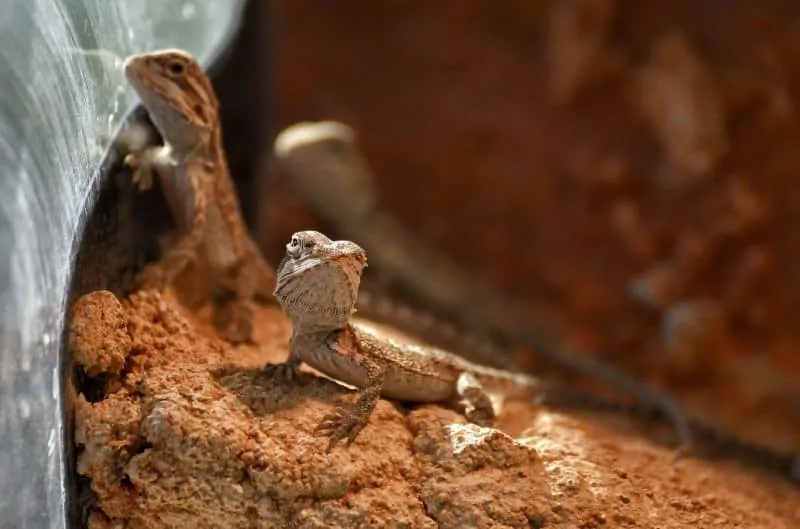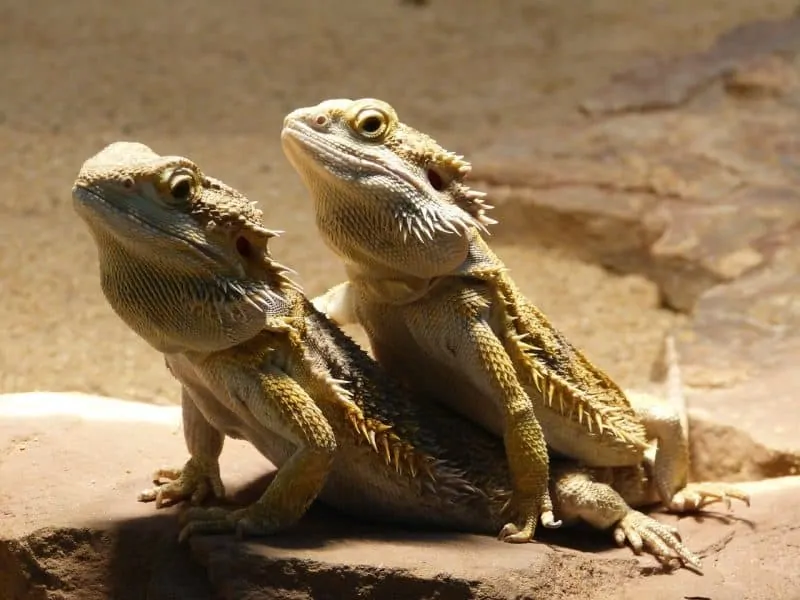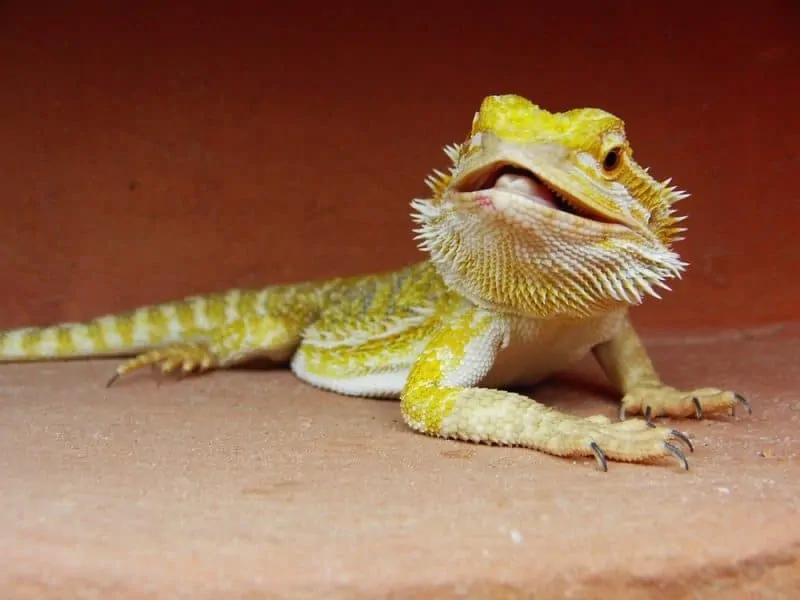April 5th, 2024: Article reviewed and updated by Katarina Samurovic, originally written by Angela DeRiso
Bearded Dragons are ground-dwelling lizards, so securing the best possible substrate for your pet beardie is super-important.
The right substrate will allow your bearded dragon to have a good grip when walking, display natural behavior, and it will properly support his joints.
The advice has changed a lot over the years, and you may find yourself confused by all the contradictory information.
Let’s solve the mystery of what are currently considered the best substrates for bearded dragons.
Good And Bad Substrates
Here is a summary of what substrates to consider and what to avoid.
Good substrates
- Bioactive-ready arid mixes
- DIY Topsoil-Playsand mix
- Stone slates
- Excavator clay
- Paper towels
- Newspaper
Bad substrates
- Calcium sand
- Pure sand (any type)
- Crushed walnut shells
- Wood shavings and bark
- Pebbles
- Linoleum
- Reptile carpet (debated)
History of Bearded Dragon Substrates – What Changed?
Opinions on the best bearded dragon substrates have changed over time. The evolution of these new trends and products is the main reason for this big article update.
A long time ago, sand was the preferred substrate for bearded dragons due to the idea that these lizards “come from deserts.” However, not all deserts are sahara-like, and beardies did not evolve to surf sand dunes. They hail from the mostly compact dry ground of Australian deserts. That is why pure regular sand and “fortified” calcium sand have caused multiple health problems in captive bearded dragons.
Because of the issues, especially the impaction risk, artificial and easily replicable substrates became the norm in the reptile hobby. Until recently, the recommendation to keep your lizard on paper towels and reptile carpets was a default almost everywhere.
However, things have moved forward. Today, there is a strong preference for natural arid or bioactive loose substrates. They provide the healthiest and most stimulating environments for bearded dragons, with minimal health risks.
The reptile market has recognized this trend, so now we finally have low-risk, well-balanced arid substrates commercially available and tried-and-tested DIY mixes. Paper towels, newspapers, and tiles still have their place in the hobby. They can be used for quarantined or special-needs dragons or as emergency housing options.
Best Bearded Dragon Substrates – Pros and Cons
Important note. There is still some impaction risk with all loose substrates. When using loose substrates, you must ensure all other conditions in the tank – especially temperature – are just right. Use wide feeding trays to serve food. I would advise using tiles, slate, or paper towels instead for weak or sick beardies.
Natural Arid Substrates
The companies finally got it right and started creating more complex substrate mixes that replicate those found naturally in arid habitats.
Here are several great commercial options for bearded dragons.
- Jurassic Natural Australian Desert Dragon Habitat. Ethically sourced directly from Central Australia, the original beardie habitat. Sellers claim it retains heat longer because of its geological properties.
- Bio Dude Terra Sahara. This bioactive-ready substrate has everything it needs to support both the needs of your beardie and other forms of in the bioactive setup. However, you can use it even if you don’t plan on going bioactive.
- Josh’s Frogs BioBedding Desert Bioactive Substrate. Has all the characteristics of a quality bioactive-ready substrate, plus the color is nice.
- Arcadia Earth Mix Arid (available mostly in Europe). Desert species mix for one of the top reptile goodies producers. It contains pieces of porous volcanic rock (Arcadia claims it’s fully digestible) that can provide additional minerals to your lizards but doesn’t lure them into licking it like Calcium sand does.
Pros: Professionally mixed substrates with all the needs of desert-dwellers considered. They support natural activity and joint health, plus they look great.
Cons: Can be costly if you’re not going bioactive and thus have to change the entire substrate volume often.
DIY Bearded Dragon Substrate
You can save money and create a natural beardie substrate by mixing the following ingredients:
- 40% organic topsoil (no additives such as pesticides and fertilizers; sift if needed!)
- 40% play sand,
- 20% Excavator Clay
If you don’t have Excavator Clay, go for 50-50% topsoil-sand mix.
In the case you are worried about germs and parasites, you can sterilize soil and sand by baking them at 200°F for about 2 hours.
Pros: Natural substrate that saves you money, especially if you have several enclosures and change the substrate often.
Cons: Unlike pre-made commercial mixes, going DIY takes some effort and clean-up.

Excavator Clay
Zoo Med’s Excavator Clay is a clay-based loose substrate that can be formed or molded into a shape when moist (like regular clay). So, besides providing your beardie with something to walk on, you can create hides and caves, plaster decorations, and 3D walls from artificial materials like foam.
Also, excavator clay is a perfect addition to DIY soil-sand mix.
Pros: It is the only substrate you can mold into shapes and use as a plaster, making it highly useful for naturalistic setup creation.
Cons: Some customers say it can be tricky to work with and that the molded structures crumble in time. It can be too dusty when used as a dry substrate.
Paper Towels and Newspaper
Paper substrates have fallen out of favor as default beardie beddings. However, they are still useful – the best option for quarantine tanks, baby beardie setups, temporary tanks, and all situations when you need high hygiene and substrate changes really often.
Pros: Cheap, easy to change, absorbent.
Cons: Looks ugly, doesn’t allow digging, can be too hard on joints, needs to be changed all the time. Newspaper can stain lizard’s belly and feet.
Stone Slate and Ceramic Tiles
Slate and tiles are best combined with other substrates, whether natural or paper-based, to create hard surfaces for beardies to climb and bask on. Slate is also readily used to create caves and other functional decorations in the tank. However, using either as a sole substrate can be tricky. They are definitely too hard on the beardie’s joints, do not absorb poop, and
Pros: Natural-looking, easy to clean and disinfect.
Cons: Non-absorbent, bad for joints in the long-term, can be difficult to manipulate in the tank (slate may break glass tanks).
Bioactive vs. (Just) Natural Substrate
Let’s face it – bearded dragons are messy and can poop a lot. Having microscopic and invertebrate help to clean up is more than welcome, right?
That’s the whole point of bioactive tanks.
In bioactive tanks, you have an entire ecosystem of tiny waste-eating organisms – the so-called clean-up crew (CUC) – that will make a lunch out of your dragon’s mess.
There is still a debate about whether you can create a long-running arid bioactive vivarium because most CUC organisms, like isopods and springtails, strongly prefer humid environments. However, there are species that are more drought-tolerant and worth trying out.
To create an arid bioactive setup, you need to add some biomass like leaf litter and sphagnum moss to your natural substrate to provide food and shelter for the clean-up crew. Then add the CUC organisms themselves. Arid springtails, powder blue isopods and powder orange isopods are most common choices. Even mealworms can be added to the mix – they will eat the feces and provide your beardie with an additional snack.
Using a bioactive terrarium inoculator like Bio Shot enhances your chances of success. It adds beneficial microfauna and natural plant fertilizers.

Bad Substrates For Bearded Dragons
Let’s have a quick overview of why substrates we listed as bad make a poor choice for a bearded dragon tank.
Calcium Sand
Calcium sand evolved from the fear of metabolic bone disease (MBD) but turned out to be an utter failure. Although I acknowledge there are hobbyists who use calcium sand with no issues so far, it is the worst possible choice for a bearded dragon setup.
Calcium sand is actually not real sand but fine calcium carbonate, so chemically, it is more similar to chalk than true sand. That is where the health issues come from.
Just like chalk dust, calcium sand can cause irritation of the eyes, skin, and lungs. Also, although it is digestible, calcium carbonate is an antacid—it neutralizes stomach acid. So, besides physically blocking the digestive organs if ingested in larger quantities, it also chemically reduces your lizard’s digestive power.
With so many options on the table, it makes no sense to risk your beardie’s well-being with such an unnatural and potentially harmful substrate.
Pure sand
Although natural by composition, sand is not a natural substrate for beardies since very few places on Earth have their ground made out of 100% sand – and those places are not really full of life (sorry, dear sand snakes, I’m aware of your lonely existence!)
In short, pure sand doesn’t properly support your bearded dragon’s mobility and can cause impaction if ingested and irritation if it gets into the eyes.
On the other hand, you can use both play sand and commercial versions such as. Just skip dyed sand altogether. It is almost sure to leach color onto the surroundings, including your pet.
Bark, Wood Chips, Walnut Shells
These popular products might be “natural” in their origins, but they are in no way natural substrates for bearded dragons or any other reptile. No lizard, especially a desert dweller, lives on what’s basically woody waste.
Using these substrates can be harmful in multiple ways. The particles are indigestible, can cause impaction or bleeding in the GI tract, and can irritate skin and eyes. The movement and digging on these substrates are not natural and probably feel extremely weird to beardies.
Eco Earth
While this is a decent substrate for humidity-loving reptiles, it is unsuitable for desert lizards like beardies. It soaks up moisture when wet and becomes dusty when completely dry. Neither is good for a bearded dragon’s tank – both the dust and the raised humidity levels have the potential to cause respiratory illness in beardies.
Vinyl and Linoleum Flooring, Shelf Liners
These “substrates” used to be favored options in the past, but not anymore. True, they are easy to wash and look less boring than paper towels, but they do not support natural movement (because they are slippery), are hard on joints and feet, and can leach harmful chemicals, especially when exposed to light and high heat normal in an exotic terrarium. The same goes for many artificial “pads” designed for reptile tanks.
Reptile Carpets (Debated)
Reptile carpets are still widely used by reptile keepers, especially beginners. They are designed to be absorbent, movement-supportive, and risk-free regarding impaction.
However, reptile carpets also have their own issues. Their absorbent structure makes them an ideal breeding ground for bacteria, quickly leading to foul odors. Thus, you’ll have to machine-wash your carpet every week and then replace it when all that washing causes the synthetic carpet fibers to stick out.
Last but not least, reptile carpets don’t allow digging and burrowing, which is a beardie’s natural behavior.
If you still prefer reptile carpets, buy proven reptile brands and check if they’re bearded-dragon friendly to avoid claw issues. Also, closely follow the instructions on washing and replacement.
Bedding Maintenance
Natural Desert Bedding (non-bioactive)
All natural desert-type substrates can be spot-cleaned daily and replaced altogether every few months. By spot cleaning, I mean removing individual poop and food pieces regularly. If you do spot cleaning properly and your dragon is healthy, there is no need to rush with the full substrate replacement.
Bioactive Substrate
You should only remove larger poo and food pieces from a functioning bioactive setup. The point of bioactive bedding is to have other organisms clean for you. Thus, you should never clean out all the substrate (because you’d be destroying your ecosystem!). The only situation where you should remove and disinfect everything is if your beardie gets coccidia or another parasitic infection.
Paper Towels and Newspapers
Paper bedding is easily changed and thrown out. Be sure to clean the surface underneath with a reptile-safe cleaner, and replace with fresh newspaper or paper towels.
Reptile Carpet
You’ll have to wash according to the label once a week. Have two carpets for your tank, so while you wash and dry the first one, you can replace it with a spare one. Over time, reptile carpet will start fraying and have more and more loose fiber sticking out. At that point, it’s a good idea to replace it.
It’s your turn!
Bearded dragon substrates can be a controversial and dividing topic, depending on who you talk to.
For decades, the entire community played it safe with artificial solid substrates. Now, the voices saying that natural desert substrates are not simply an aesthetic choice but a real biological need for beardies are getting louder and more supported day after day. I have to say I agree with them.
Remember that impaction origins are much more complex than substrate type. Other factors like food, vitamin deficiencies, and tank temperature play a crucial role in susceptibility to this dreadful health issue. Although we should be careful and take precautions, we shouldn’t blame it all on the loose substrates – facts don’t support it (except in the infamous case of calcium sand).
Did you enjoy the article? Do you agree with the new reptile tank bedding trends? Let us know in the comments – they make the discussion ever better!



6 Comments
Hi. First time reader of your articles- even though I’m not a new ‘dragon’ owner, I feel there’s always something new I can learn, or a different opinion to consider- in this case, sand in an adult enclosure… I was told when first got my baby, it was unsafe to have sand in the terrarium, however when they became adults it was ok to to use it as substrate. But you’re saying, no matter what age, impaction is always a risk? I obviously don’t want to take that chance!- My Lou is almost 8 years old! Without a doubt part of the family, and treated like my 3rd child. Better safe, than sorry!…
#2 We’ve always thought “LouLou” was a female and planned to get a second to live with her. But after a few years of no infertile eggs, realized She was HE! (and became Lou) I’ve also always been told not to house 2 males together! Do you disagree with that? Could I put another in the same tank? He lives in a roomy 125 gallon enclosure! But is constantly scratching at the glass, wanting my attention everytime I pass by! I feel he could use a buddy, besides me. But I wouldn’t want to put the guy in danger if my big guy gets territorial. And if the new buddy ends up being a little girl, I would inevitably end up with a little of lizards… I’m curious your thoughts and opinions on these things…
Hi Christina,
It’s so lovely you say you treat the beardie like your own baby – trust me, I know the feeling!
There indeed is less of a risk for impaction when the bearded dragon’s stomach becomes larger as they develop. But, the risk is still there! It’s only less. That’s why I would definitely consider safer alternatives for a substrate.
I can confirm that the advice you’ve been given – about not housing two beardies together – is a good one, especially if they are both males. They would be stressed by each other’s presence constantly and fights would be unavoidable. Cohabitation is a problem with less territorial species, let alone bearded dragons who are very territorial.
Keeping male-female and female-female pairs together also comes with its own problems. In the first arrangement, the female would be pressured to breed all the time during the season, which would be highly stressful. Two females, although not displaying the former problems, could pick a fight about food and get severely injured.
In short – cohabitation is not recommended, and the safest thing to do is to keep ’em separated.
Good luck!
When we got ours sand was used. Since we have removed the sand and for right now have paper towels down. She is not a happy camper. She refuses to get off her log. I have ordered a mat but until then what should we do?
Hi Kathryn,
I feel for your beardie. That is why I personally like to use natural substrates whenever appropriate – and they seem to be making a comeback. I don’t know how things have worked out with the mat/carpet, but have you considered trying out modern, safer natural substrates like Excavator Clay, or bioactive arid mixes? We are preparing an article on these soon – until then, feel free to do your own research on them. Good luck!
Thank you so much for all of this information!!! Very helpful. New dragon owner just trying to learn more. I removed the sand from her terrarium today, I did not know that it could be dangerous. Also trying to read up on different flooring ideas that are safer, & easy to change or clean.
Thanks for the info. I’m new to beardies. Trying to keep him or her ? safe.